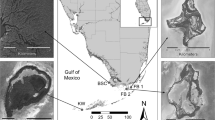Abstract
In this study, we used the stable isotope ratios 15N/14N and 13C/12C to clarify the spatial and temporal patterns of small mammal derpredation by wide-ranging raptors across a salt marsh and grassland landscape. To determine whether clear isotope signals existed for the two adjoining habitats, and if these differences could allow for an assessment of the seasonal habitat origins of depredated rodents, primarily the vole, Microtus californicus, we investigated the nitrogen and carbon isotope ratios for three sets of data. First, to establish potential differences in isotope signatures between the two habitats, we collected plant species consumed by the vole. Second, we analyzed bone collagen from voles originating from known locations along a gradient from marsh to grassland. Finally, the signatures of these unpredated voles were then used to categorize isotope values of vole remains found in the pellets of their raptor predators. Results indicated that mean δ15N and δ13C were both higher in marsh plants than in grassland species. Although both isotopes showed a trophic level increase from plant to bone collagen, nitrogen provided the more informative signature when attempting to distinguish the habitat origins of voles. We found that the δ15N values of unpredated voles were significantly related to the distance of the specimen along the marsh-grassland interface, with higher values in the marsh habitat. Analysis of the depredated bones found in raptor pellets indicated that a greater percentage of voles originated in grassland during the spring/summer season (88%), as compared with the fall/winter period (60%). Finally, we compared this pattern of habitat and season-specific predation to another measure of predation risk, the relative encounter rates of raptors foraging for voles, and found that the two estimates were similar except during the winter season. This study demonstrates the usefulness of stable isotope analysis for elucidating seasonal patterns of predation across a complex landscape.
Similar content being viewed by others
Author information
Authors and Affiliations
Additional information
Electronic Publication
Rights and permissions
About this article
Cite this article
Harding, E.K., Stevens, E. Using stable isotopes to assess seasonal patterns of avian predation across a terrestrial-marine landscape. Oecologia 129, 436–444 (2001). https://doi.org/10.1007/s004420100729
Received:
Accepted:
Published:
Issue Date:
DOI: https://doi.org/10.1007/s004420100729




